The New York Times’s wedding section is a perfect natural experiment designed to answer the question: What do the world’s most self-important people think is important?
Introducing WeddingCrunchers.com, a searchable database of nearly 60,000 NYT wedding announcements from 1981 through 2016. Plot n-gram frequency and visualize trends across 30+ years of yuppie nuptials
There has never been a shortage of hora-chair commentary on the New York Times Weddings & Celebrations section, and it’s not hard to see why: New York is the status-consciousness capital of our status-conscious culture, and this makes the Times’s wedding section a perfect natural experiment designed to answer the question, What do the world’s most self-important people think is important?
The neat thing about these announcements is that they’re fairly structured—if you read a bunch of them, you’ll notice patterns in the way couples are introduced and how their basic “stats” are phrased. This makes it possible to test our intuitions about trends like:
- The decline of debutante culture
- When exactly Wall Street hit its period of peak decadence
- How the average age of well-to-do brides changes over time
- Whether Princeton’s stricter grading standards have resulted in the “nightmare scenario” envisioned by a concerned student in the Times itself
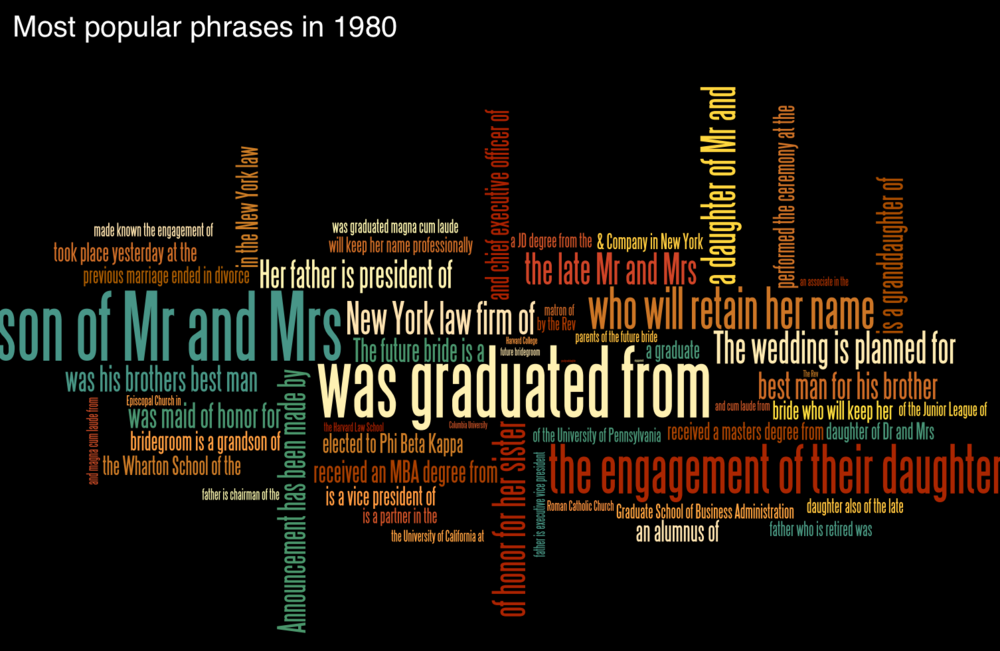
This is why we built WeddingCrunchers.com, a searchable database of about 60,000 Times wedding announcements published between 1981 and 2013. Specifically, Wedding Crunchers lets you measure the frequency of specific words and phrases in these announcements. When you search for a phrase (technically called an n-gram), you get back a graph displaying how usage of that phrase fluctuated over time.
Let’s see what we can find out with this powerful tool at our disposal.
Age Ain’t Nothing but a Number
As most young professionals (and every parent of a young professional) in New York could tell you, “the average age of people getting married is on the rise.” Why, I’d have to check, but there might have even been a few NYT Most E-Mailed articles on the very subject…
But is this popular conception borne out by the data?
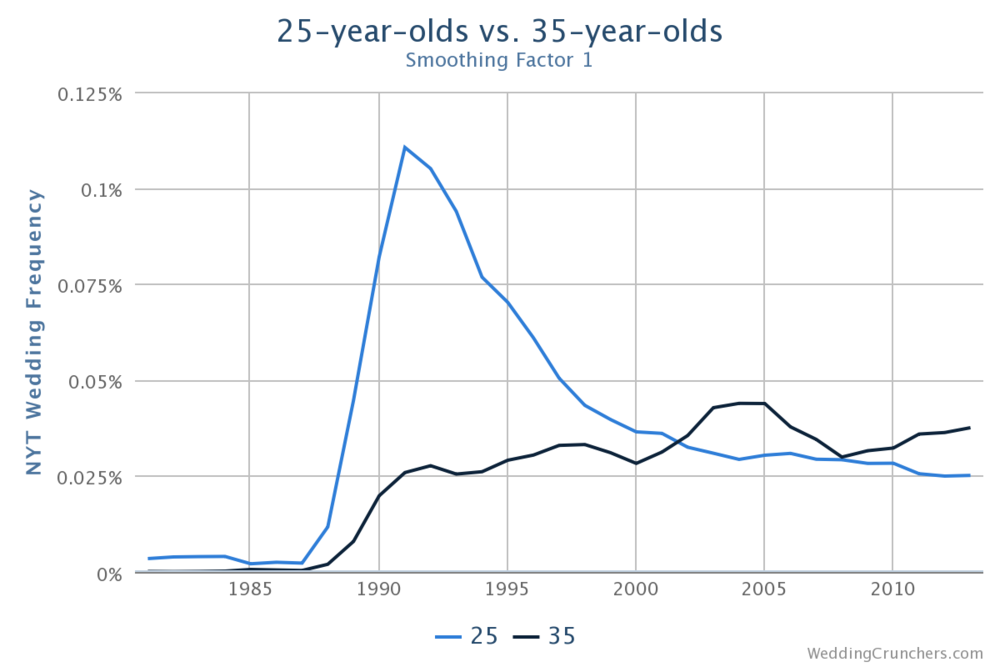
The graph shows how frequently the terms “25” and “35” appeared in New York Times wedding announcements from 1980 to today.
When the Weddings column started including ages in the early 1990s, you were more than four times as likely to see a 25-year-old in an announcement than you were a 35-year-old, but by the early 2000s, 35-year-olds had completely closed the gap. Today you’re slightly more likely to see a 35-year-old than a 25-year old! Brides tend to be a bit younger than grooms, but the trends are similar for both sexes.
Let’s get a broader pictures of how ages have changed in the past two decades of wedding announcements:

Notice how the peak starts well to the left side of the graph in 1990 but then flattens and shifts to the right throughout the 2000s. Interestingly, it looks like the trend might have reversed itself by a small amount in the most recent years, but overall the distribution has clearly shifted to the right.
“Republicans buy sneakers, too”
—Michael Jordan (maybe), on his decision not to endorse Democrat Harvey Gantt in the 1990 North Carolina Senate race
The Times has a famously liberal editorial board. Have its wedded couples trended in the same political direction? Let’s search Wedding Crunchers for mentions of Democrats and Republicans—you know, stuff like “the groom’s father, a Democrat, is a senator from New Jersey”:

Back in the early Reagan days, you were actually more likely to see a Republican mentioned in the weddings section than a Democrat, but as the metropolitan area has become progressively more blue and Rockefeller Republicans have joined the list of endangered species, the political affiliation of the staffers, children of politicians, and politicians themselves getting hitched has reflected the surging Democratic tide of New York.
The Demographics Of Times Wedding Announcements They Are a-Changin’
Let’s not kid ourselves—the Times’s weddings column is indelibly associated with two demographics: Jews and WASPs. As it turns out, though, the wedding announcements have become more diverse over the past 30 years, perhaps deliberately on the part of the Times’s editors, organically on the part of New York’s evolving population, or some combination of both.
It’s hard to ferret out a WASP directly, but there are plenty of excellent proxies we can look at—traditional WASPy institutions like boarding schools, suffixes, and Fairfield County, Connecticut. Let’s see how those are doing:




So we see that references to famous boarding schools are all on the decline, although that appears to be part of a broader trend toward excluding high school credentials from the announcements. There are fewer “III” suffixes, and the traditional, affluent towns of Connecticut’s Gold Coast are also referenced less frequently. These data points are by no means conclusive, but they all support the notion that the weddings section has shed at least some of its aristocratic roots. Perhaps though the strongest indicator of the decline of the weddings section’s blue-bloodedness can be seen in the following chart:

Meanwhile, the words “Muslim”, “Buddhist”, and “Sikh” have all seen small increases, but “Hindu” has really exploded:
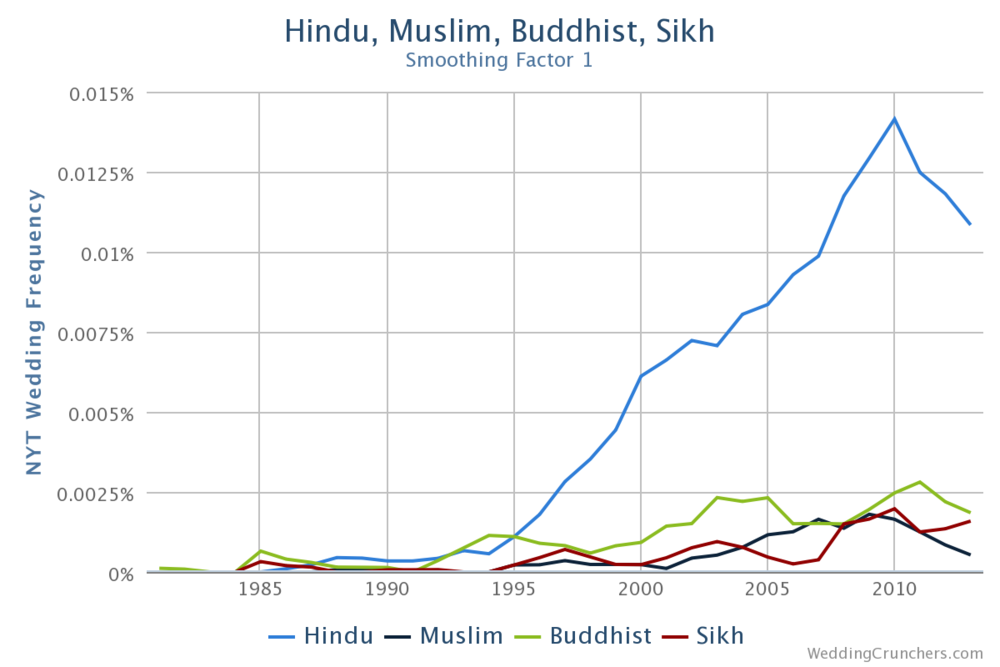
This seems consistent with demographic trends, namely that the city’s Indian population increased by 118% from 1990 to 2000, while the city’s overall population grew by 9%.
That might not be the whole story, though. The NYT and other media outlets have reported on South Asians’ growing presence on Wall Street, and if you believe that the wedding announcements largely reflect people on Wall Street (more on that later), and there are more Indians on Wall Street, then you would expect to see more Indians in the weddings section.
Another way to consider diversity over the years is to examine sets of surnames commonly associated with certain ethnicities:
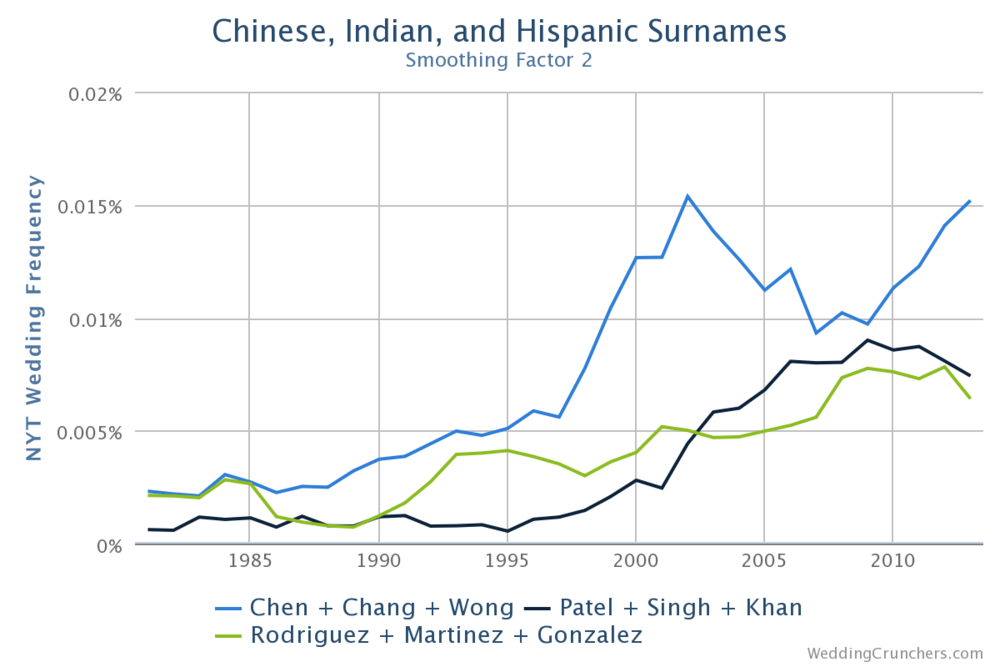
From this graph we can see that Chinese, Indian, and Hispanic names have all become more frequent, with the Chinese making the largest increase. The increase in Indian names has been more recent, and the increase in Hispanic names has been the most gradual.
Now let’s compare those names to the single most popular Jewish surname, Cohen:
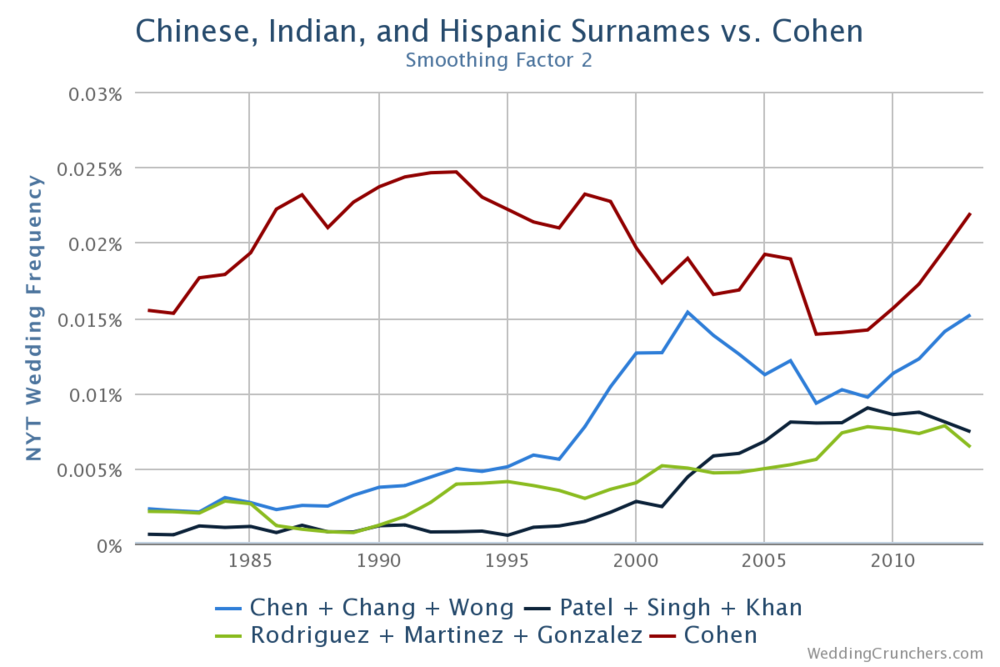
Hmm, ok, so while the Cohens haven’t seen an increase, they’re still ahead of the top 3 for the other ethnicities all by themselves! If we add in other common Jewish surnames like Goldberg and Rosenberg, the gap is even more dramatic.
So we can see that some things change less than others. Nowhere is that clearer than in… the Ivy League.
“To those of you who received honors, awards, and distinctions, I say, ‘Well done.’ To the ‘C’ students, I say, ‘You, too, can be president of the United States!’
—President George W. Bush, to Yale’s graduating class of 2001

Columbia is the most mentioned of the Ivies, followed closely by Harvard. Dartmouth is consistently the least mentioned, and the rest are bunched in the middle. Remember, though, that the Ivies vary widely in total student enrollment, particularly in the number of graduate students.
Dartmouth is the smallest of the Ivies as measured by total student enrollment, so in some sense it’s only natural that it would be the least mentioned. It’s also the farthest from New York, which might mean that its alumni are less likely to live in the city, and therefore less likely to appear in the Times when they get married. By the same token, Columbia is in New York, so it probably has the highest percentage of its graduates living or working in the city.
Let’s compare the total enrollment of each school to its representation in the Times weddings section:

It appears that after adjusting for student population, Princeton is the most overrepresented of the Ivies, while Cornell is the most underrepresented. Take this with a grain of salt though, because the table doesn’t account for changes in enrollment over time, what percentages of each school’s graduates move to New York City, and the relative propensity for undergraduate alumni to be in the weddings section compared to graduate students (to say nothing of the stratification within graduate schools, namely among professional, doctorate, and other master’s degree programs).
You can’t talk Ivies in the Times without taking a look at Latin honors. Some Princeton students have expressed dismay that they are graded more strictly than their Yale counterparts, while Harvard embarked on its own quest a few years ago to crack down on the ease with which it handed out Latin honors. What does the Wedding Crunchers data say? We can used the advanced query feature to calculate the percentage of each school’s mentions that are preceded by the phrase “cum laude”:
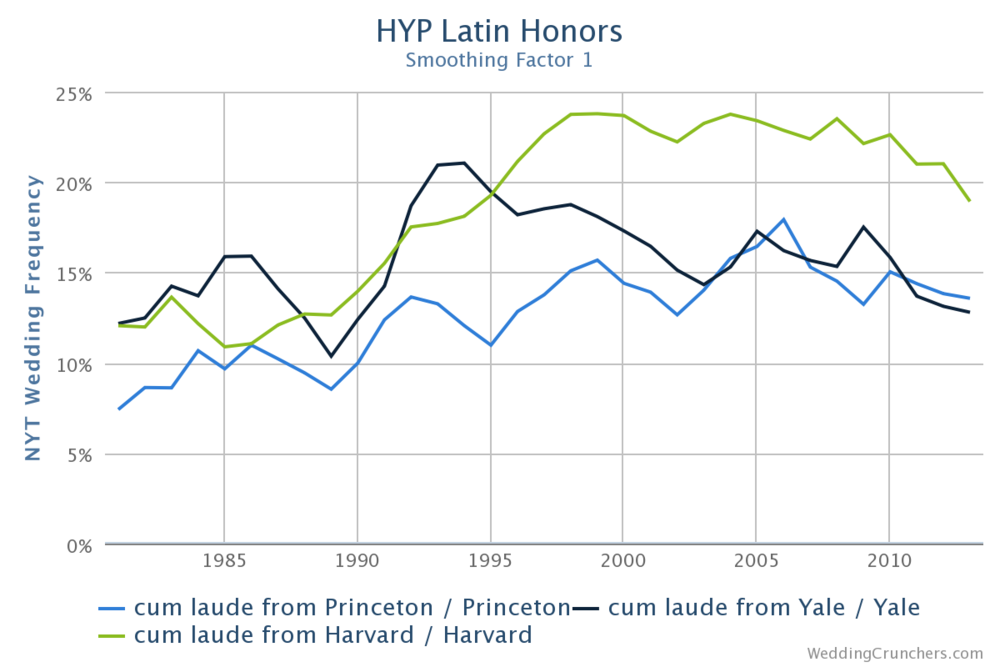
Sure enough, Harvard appears to have the highest rate of graduates with Latin honors, while Yale and Princeton look comparable. Again, though, we should consider graduate programs: many of them don’t offer Latin honors, so graduate students might be contributing to the denominators in the above data without counting toward the numerators, lowering the overall ratios. Harvard is nearly ⅔ graduate students, Yale is closer to 50/50, while Princeton is about ⅔ undergraduates, so it might well be that all of the ratios should be higher by some degree, with a bigger relative increase for Harvard and a smaller increase for Princeton.
But no matter which Ivy League school you attended, you’re going to have trouble name-dropping Phi Beta Kappa in your wedding announcement:

This is because in 1999 the NYT officially stopped allowing people to list Phi Beta Kappa honors in their announcements!
All of the Ivies have been co-ed for quite some time. We can see that the Seven Sisters colleges used to be mentioned quite frequently, but have experienced significant declines, especially the ones that haven’t gone co-ed themselves:

Are there any other colleges that can compete with the Ivies for total popularity in the weddings section?

This list is by no means conclusive, but NYU fares very well, while Duke and Stanford have also crept into the realm of the less frequently mentioned Ivies.
Which brings us to a riddle: what do nearly all elite colleges have in common? The answer, of course, is: kids who want to work on Wall Street.
To Have and to Goldman
They used to say, “As G.M. goes, so goes the nation.” Today they might as well replace “G.M.” with “Goldman Sachs,” and “the nation” with “the salesmen at Ferrari & Maserati of New York.”
Let’s look at some of the bigger names on the street:

You’ll notice that Merrill Lynch used to be way more cited than it is today. Wait a minute: does Merrill even exist anymore? Ah yes: It was bought by Bank of America at the depths of the financial crisis, or maybe BofA was forced to buy it by the Federal Reserve, but either way, it’s not quite as popular to include in wedding announcements anymore.
What about the banks that didn’t make it at all? Come to think of it, don’t Wall Street firms have this weird propensity to blow themselves up every few years, with long enough gaps in between that everyone forgets and gets all shocked when it happens again?

And out of the ashes, the hedge funds rise:

Perhaps it’s a coincidence, but it’s worth noting that the usage of “hedge fund” in wedding announcements peaked in 2007, the same year that many high-profile funds suffered unprecedented losses as the financial crisis swung into high gear.
Of course, not to be outdone by Wall Street, Big Law has its foot pretty firmly in the Times wedding scene door, to say nothing of the aspiring doctors and consultants of the world. Let’s do a quick professional school analysis:

Overall it looks like the lawyers win, with the business students in the middle (and trending down), while the doctors are in third, but apparently riding an upward trend. One thing lawyers, doctors, and bankers share in common, though: they all have to live somewhere, and it better be somewhere nice!
“Everybody tells you they hate the Upper East Side. They wanna live on the West Side. But believe me, when it’s resale time, the East Side moves all the time. I mean what do you got on the West Side? Sean and Madonna?”
—Sylvia Miles, Wall Street (1987)
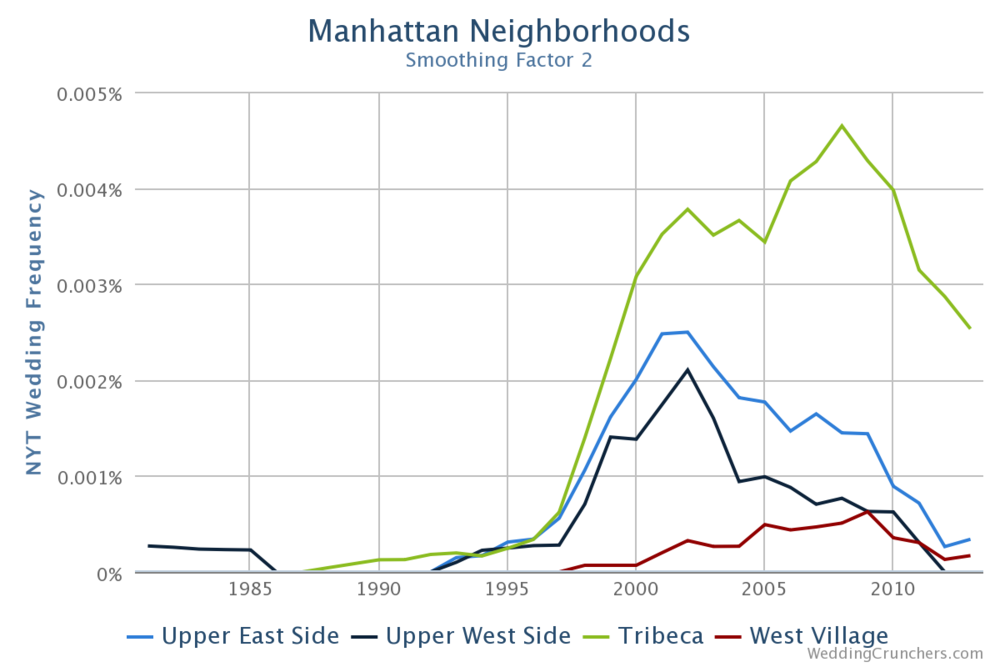
The Times’s wedding announcements didn’t include references to specific neighborhoods until the late 1990s, but now that they do, it would appear that Tribeca is all the rage. Closer examination, though, reveals that many of the Tribeca references are actually wedding venues, in particular the Tribeca Grand Hotel and the Tribeca Rooftop event space.
Let’s give venues a closer look:
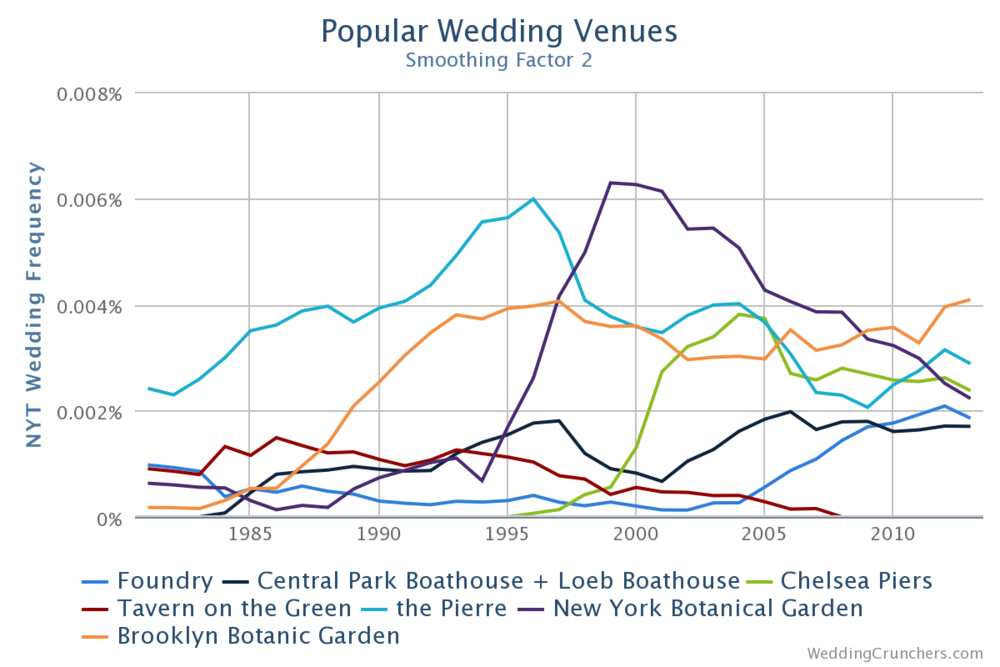
The Brooklyn Botanic Garden has recently surpassed the New York Botanical Garden (the one in the Bronx) and the Pierre as the top venue. Perhaps it’s part of some heretofore unexplored trend toward a cooler, hipper Brooklyn?
“Helen Hillson. She’s a lawyer. She’s keeping her name.”
There are infinitely many more questions we could analyze, including but not limited to:
- The rate at which women are “keeping their names”
- Same-sex weddings
- Mentions of online dating sites and social media
but at this point, if you’re still here, it might be best to set you free and let you run your own searches at WeddingCrunchers.com. Enjoy, and be sure to share any interesting results that you discover!
5/31/2016 update: I wrote another article about the weddings section for Vox